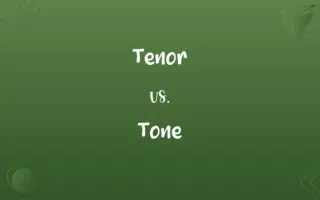Pine vs. Cypress: Know the Difference

By Dua Fatima & Hifza Nasir || Published on April 28, 2024
Pine trees are coniferous, known for their long, soft needles and use in timber, while cypress trees have short, hard needles and are often used for ornamental purposes.

Key Differences
Pine trees belong to the genus Pinus and are characterized by their long, soft needles that usually come in bundles of two to five. These trees are widely valued for their timber, which is soft, lightweight, and versatile, making it ideal for construction and furniture. On the other hand, cypress trees, belonging to the family Cupressaceae, feature short, hard needles and a distinctive, often conical shape. Their wood is known for its durability and resistance to rot, making it a popular choice for outdoor uses, including landscaping and construction in wet environments.
Dua Fatima
Apr 28, 2024
While pine trees typically grow in cooler climates and can be found in large forests, cypress trees thrive in a wider range of environments, from temperate to tropical. This adaptability allows cypress trees to be a common sight not just in natural settings but also in urban landscapes, where they are used as windbreaks, privacy screens, and ornamental plants. In contrast, pines are often planted for reforestation efforts and commercial wood production, owing to their fast growth and economic value.
Dua Fatima
Apr 28, 2024
Pine trees produce cones that are usually elongated and hang downwards after maturing, which helps in seed dispersal. Cypress trees, however, bear smaller, rounder cones, and their seeds are often distributed by water, reflecting their affinity for moist environments. This difference in seed dispersal mechanisms highlights the adaptation of each genus to its preferred habitat.
Dua Fatima
Apr 28, 2024
The resin of pine trees is another distinguishing feature, being abundant and used in various industries for making turpentine, rosin, and other products. Cypress trees, while they also produce resin, are less known for this aspect, with their wood's natural preservatives being more commercially significant. This resinous quality in pines contributes to their distinctive smell, which is often associated with cleanliness and freshness.
Hifza Nasir
Apr 28, 2024
In terms of ecological benefits, both pines and cypresses play crucial roles in their environments. Pine trees are important for preventing soil erosion and offering habitat and food for wildlife. Cypress trees, particularly those in wetland areas, help in water filtration and provide critical support for aquatic ecosystems. Despite their differences, both contribute significantly to biodiversity and environmental health.
Hifza Nasir
Apr 28, 2024
ADVERTISEMENT
Comparison Chart
Use
Timber, construction, furniture
Landscaping, outdoor construction, ornamental
Dua Fatima
Apr 28, 2024
Seed Dispersal
Downward-hanging cones, wind-dispersed
Smaller, rounder cones, often water-dispersed
Dua Fatima
Apr 28, 2024
ADVERTISEMENT
Resin Production
Abundant, used for turpentine, rosin
Less noted for resin, valued for wood preservatives
Dua Fatima
Apr 28, 2024
Ecological Role
Soil erosion prevention, wildlife habitat
Water filtration, support for aquatic ecosystems
Shumaila Saeed
Apr 28, 2024
Pine and Cypress Definitions
Pine
A coniferous tree known for its long, soft needles and versatile timber.
The pine tree in our backyard provides excellent shade in summer.
Dua Fatima
Mar 04, 2024
Cypress
A tree with short, hard needles, known for its durable, rot-resistant wood.
Cypress trees line the driveway, adding elegance to the landscape.
Dua Fatima
Mar 04, 2024
Pine
Pines are crucial for reforestation and commercial wood production.
The new pine plantation will help meet the demand for sustainable timber.
Dua Fatima
Mar 04, 2024
ADVERTISEMENT
Cypress
Often found in wet environments, cypress trees are adaptable to various climates.
The cypress swamp is home to diverse wildlife species.
Hifza Nasir
Mar 04, 2024
Pine
Pine trees produce elongated cones and are valued for their wood.
Pine furniture is popular due to its durability and aesthetic appeal.
Dua Fatima
Mar 04, 2024
Cypress
Used ornamentally and for constructing in moisture-prone areas.
The garden's cypress wood fence withstands the rainy season well.
Dua Fatima
Mar 04, 2024
Pine
Characterized by a distinct resinous smell, beneficial for various products.
The scent of pine resin is often used in cleaning products for its freshness.
Hifza Nasir
Mar 04, 2024
Cypress
Cypress seeds are typically water-dispersed, reflecting their affinity for moist habitats.
After the flood, new cypress saplings sprouted along the riverbank.
Dua Fatima
Mar 04, 2024
Pine
These trees play a significant role in preventing soil erosion.
Planting pine trees on the hillside has reduced landslide incidents.
Shumaila Saeed
Mar 04, 2024
Cypress
These trees contribute to water filtration and support aquatic ecosystems.
The cypress wetland area plays a vital role in purifying the local water supply.
Hifza Nasir
Mar 04, 2024
Cypress
Any of several similar or related coniferous trees, such as the bald cypress.
Dua Fatima
Mar 03, 2024
Cypress
Any of numerous evergreen conifers of the genus Cupressus of north temperate regions having dark scalelike leaves and rounded cones
Dua Fatima
Mar 03, 2024
Pine
Any of various evergreen trees of the genus, having fascicles of needle-shaped leaves and producing woody seed-bearing cones. These trees are widely cultivated for ornament and shade and for their timber and resinous sap, which yields turpentine and pine tar.
Dua Fatima
Mar 03, 2024
Cypress
Any of various evergreen trees or shrubs of the genus Cupressus, native to Eurasia and North America and having opposite, scalelike leaves and globose woody cones.
Dua Fatima
Mar 03, 2024
Repeatedly Asked Queries
What distinguishes pine trees from cypress trees?
Pine trees have long, soft needles and are known for their timber, whereas cypress trees have short, hard needles and durable, rot-resistant wood.
Hifza Nasir
Apr 28, 2024
How do pine and cypress trees contribute to the environment?
Both types of trees play crucial roles, with pines helping prevent soil erosion and cypresses supporting aquatic ecosystems through water filtration.
Shumaila Saeed
Apr 28, 2024
Why is pine wood popular in furniture making?
Pine wood is popular for its softness, lightweight nature, and versatility, making it ideal for various furniture styles.
Dua Fatima
Apr 28, 2024
Are cypress trees only used for ornamental purposes?
While cypress trees are commonly used ornamentally, their wood is also valued for outdoor construction due to its durability and rot resistance.
Dua Fatima
Apr 28, 2024
Do all pine trees have the same type of needles?
No, pine needles can vary in length and are typically grouped in bundles of two to five, depending on the species.
Hifza Nasir
Apr 28, 2024
Can cypress trees grow in cooler climates like pines?
Yes, some cypress species can adapt to cooler climates, but they are generally more versatile in their environmental preferences than pines.
Dua Fatima
Apr 28, 2024
Can cypress wood be used indoors?
Yes, cypress wood can be used indoors, especially in areas with high humidity, due to its natural resistance to moisture and decay.
Dua Fatima
Apr 28, 2024
How are cypress seeds dispersed?
Cypress seeds are often dispersed by water, which suits their preference for growing in or near wet environments.
Hifza Nasir
Apr 28, 2024
Is the resin from pine trees used commercially?
Yes, pine resin is commercially valuable, used in producing turpentine, rosin, and other products.
Dua Fatima
Apr 28, 2024
What makes cypress wood suitable for outdoor use?
The natural preservatives in cypress wood make it resistant to rot and decay, ideal for outdoor use in landscaping and construction.
Shumaila Saeed
Apr 28, 2024
Share this page
Link for your blog / website
HTML
Link to share via messenger
About Author
Written by
Dua FatimaCo-written by
Hifza Nasir





































































